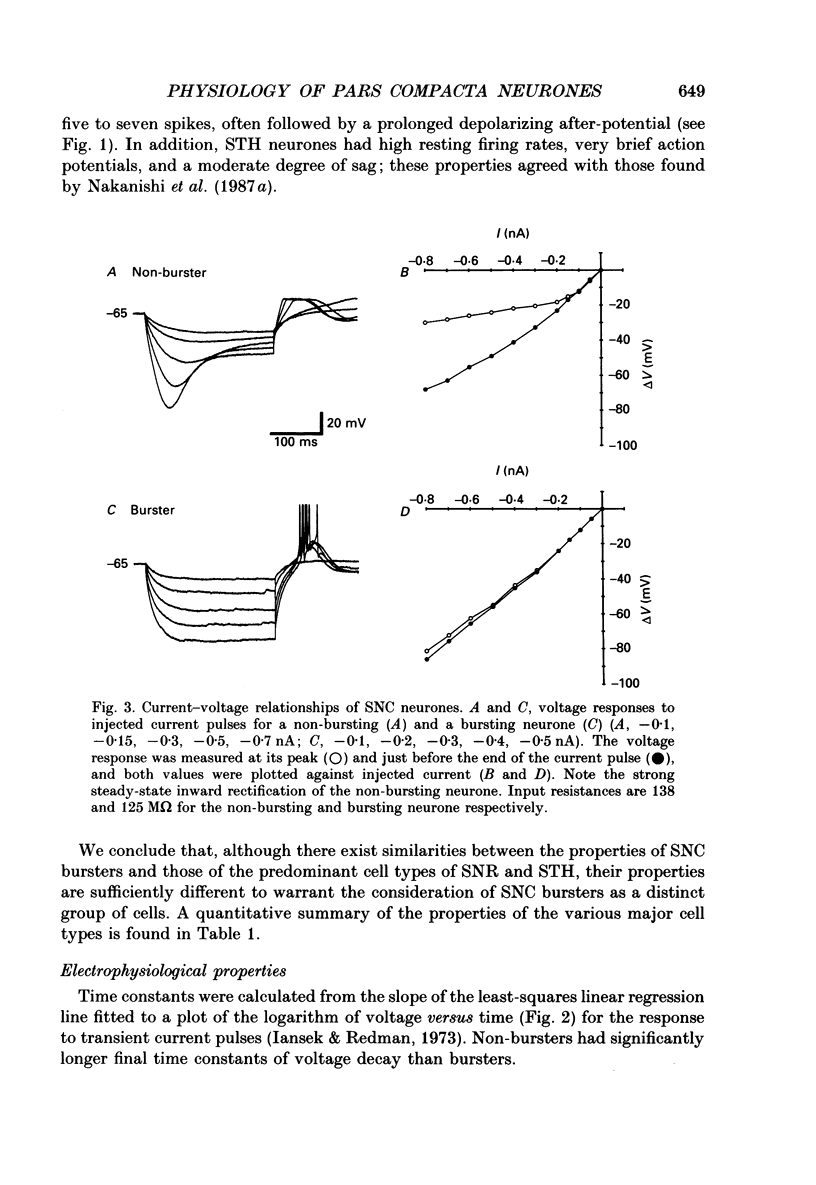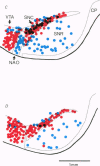Abstract
1. The membrane properties of substantia nigra pars compacta neurones were studied using an in vitro slice preparation of guinea-pig midbrain. 2. Neurones were divided into two classes based on their electrophysiological properties: bursting neurones displayed a burst of several rapidly accommodating action potentials in response to relaxation of hyperpolarizing current injected through the microelectrode, while non-bursting neurones produced regularly spaced action potentials. These neuronal types were found to be electrophysiologically distinct from those recorded in the substantia nigra pars reticulata and the subthalamic nucleus. 3. Non-bursting neurones, which comprised ca 85% of the sampled cells, were characterized by a slow, pacemaker pattern of firing at rest, broad action potentials, a pronounced spike after-hyperpolarization, long membrane time constants, and strong transient outward and time-dependent inward rectification. 4. Bursting neurones, comprising ca 15% of the sample, displayed rapid firing rates at rest, fast action potentials, a shallow spike after-hyperpolarization and briefer membrane time constants. All of these parameters were significantly different from those of the non-bursting type. Bursting neurones lacked transient outward or time-dependent inward rectification. 5. Both types of cells were capable of generating pronounced calcium-dependent, low-threshold spikes in the presence of tetrodotoxin (TTX). However, only the non-bursting type displayed calcium-dependent rhythmic oscillations in membrane potential near resting potential in the presence of TTX. The firing rate, action potential shape and after-hyperpolarization of non-bursting neurones were strongly influenced by calcium-dependent currents. 6. The majority of cells were injected with biocytin, which allowed morphological reconstruction of the neurones and confirmation of their location within the pars compacta. Non-bursting neurones had variable soma shapes and their dendrites were mostly directed in a medio-lateral direction. Many cells extended some of their dendrites into the pars reticulata. Bursting neurones were mainly fusiform in shape with their dendrites oriented in a medio-lateral direction; a few had dendrites extending into the pars reticulata. 7. Thirty-six neurones were also double labelled using a combination of biocytin or Lucifer Yellow injection with tyrosine hydroxylase (TH) immunohistochemistry. Non-bursting neurones all displayed TH immunofluorescence, while none of the bursting neurones were TH positive.(ABSTRACT TRUNCATED AT 400 WORDS)
Full text
PDF
























Images in this article
Selected References
These references are in PubMed. This may not be the complete list of references from this article.
- Bourque C. W., Randle J. C., Renaud L. P. Calcium-dependent potassium conductance in rat supraoptic nucleus neurosecretory neurons. J Neurophysiol. 1985 Dec;54(6):1375–1382. doi: 10.1152/jn.1985.54.6.1375. [DOI] [PubMed] [Google Scholar]
- Crunelli V., Lightowler S., Pollard C. E. A T-type Ca2+ current underlies low-threshold Ca2+ potentials in cells of the cat and rat lateral geniculate nucleus. J Physiol. 1989 Jun;413:543–561. doi: 10.1113/jphysiol.1989.sp017668. [DOI] [PMC free article] [PubMed] [Google Scholar]
- Dray A. The physiology and pharmacology of mammalian basal ganglia. Prog Neurobiol. 1980;14(4):221–335. doi: 10.1016/0301-0082(80)90017-9. [DOI] [PubMed] [Google Scholar]
- Fox A. P., Nowycky M. C., Tsien R. W. Kinetic and pharmacological properties distinguishing three types of calcium currents in chick sensory neurones. J Physiol. 1987 Dec;394:149–172. doi: 10.1113/jphysiol.1987.sp016864. [DOI] [PMC free article] [PubMed] [Google Scholar]
- Fujimura K., Matsuda Y. Autogenous oscillatory potentials in neurons of the guinea pig substantia nigra pars compacta in vitro. Neurosci Lett. 1989 Sep 25;104(1-2):53–57. doi: 10.1016/0304-3940(89)90328-5. [DOI] [PubMed] [Google Scholar]
- Gerber U., Greene R. W., McCarley R. W. Repetitive firing properties of medial pontine reticular formation neurones of the rat recorded in vitro. J Physiol. 1989 Mar;410:533–560. doi: 10.1113/jphysiol.1989.sp017548. [DOI] [PMC free article] [PubMed] [Google Scholar]
- Gerfen C. R., Herkenham M., Thibault J. The neostriatal mosaic: II. Patch- and matrix-directed mesostriatal dopaminergic and non-dopaminergic systems. J Neurosci. 1987 Dec;7(12):3915–3934. doi: 10.1523/JNEUROSCI.07-12-03915.1987. [DOI] [PMC free article] [PubMed] [Google Scholar]
- Getting P. A. Emerging principles governing the operation of neural networks. Annu Rev Neurosci. 1989;12:185–204. doi: 10.1146/annurev.ne.12.030189.001153. [DOI] [PubMed] [Google Scholar]
- Grace A. A., Bunney B. S. The control of firing pattern in nigral dopamine neurons: burst firing. J Neurosci. 1984 Nov;4(11):2877–2890. doi: 10.1523/JNEUROSCI.04-11-02877.1984. [DOI] [PMC free article] [PubMed] [Google Scholar]
- Grace A. A., Onn S. P. Morphology and electrophysiological properties of immunocytochemically identified rat dopamine neurons recorded in vitro. J Neurosci. 1989 Oct;9(10):3463–3481. doi: 10.1523/JNEUROSCI.09-10-03463.1989. [DOI] [PMC free article] [PubMed] [Google Scholar]
- Greene R. W., Haas H. L., McCarley R. W. A low threshold calcium spike mediates firing pattern alterations in pontine reticular neurons. Science. 1986 Nov 7;234(4777):738–740. doi: 10.1126/science.3775364. [DOI] [PubMed] [Google Scholar]
- Guyenet P. G., Aghajanian G. K. Antidromic identification of dopaminergic and other output neurons of the rat substantia nigra. Brain Res. 1978 Jul 7;150(1):69–84. doi: 10.1016/0006-8993(78)90654-6. [DOI] [PubMed] [Google Scholar]
- Hanker J. S., Yates P. E., Metz C. B., Rustioni A. A new specific, sensitive and non-carcinogenic reagent for the demonstration of horseradish peroxidase. Histochem J. 1977 Nov;9(6):789–792. doi: 10.1007/BF01003075. [DOI] [PubMed] [Google Scholar]
- Harris N. C., Ramsay S., Kelion A., Greenfield S. A. Electrophysiological evidence for the dendritic localization of a calcium conductance in guinea-pig substantia nigra neurones in vitro. Exp Brain Res. 1989;74(2):411–416. doi: 10.1007/BF00248875. [DOI] [PubMed] [Google Scholar]
- Harris N. C., Webb C., Greenfield S. A. A possible pacemaker mechanism in pars compacta neurons of the guinea-pig substantia nigra revealed by various ion channel blocking agents. Neuroscience. 1989;31(2):355–362. doi: 10.1016/0306-4522(89)90379-5. [DOI] [PubMed] [Google Scholar]
- Horikawa K., Armstrong W. E. A versatile means of intracellular labeling: injection of biocytin and its detection with avidin conjugates. J Neurosci Methods. 1988 Aug;25(1):1–11. doi: 10.1016/0165-0270(88)90114-8. [DOI] [PubMed] [Google Scholar]
- Iansek R., Redman S. J. An analysis of the cable properties of spinal motoneurones using a brief intracellular current pulse. J Physiol. 1973 Nov;234(3):613–636. doi: 10.1113/jphysiol.1973.sp010364. [DOI] [PMC free article] [PubMed] [Google Scholar]
- Jahnsen H., Llinás R. Ionic basis for the electro-responsiveness and oscillatory properties of guinea-pig thalamic neurones in vitro. J Physiol. 1984 Apr;349:227–247. doi: 10.1113/jphysiol.1984.sp015154. [DOI] [PMC free article] [PubMed] [Google Scholar]
- Juraska J. M., Wilson C. J., Groves P. M. The substantia nigra of the rat: a Golgi study. J Comp Neurol. 1977 Apr 15;172(4):585–600. doi: 10.1002/cne.901720403. [DOI] [PubMed] [Google Scholar]
- Kita T., Kita H., Kitai S. T. Electrical membrane properties of rat substantia nigra compacta neurons in an in vitro slice preparation. Brain Res. 1986 Apr 30;372(1):21–30. doi: 10.1016/0006-8993(86)91454-x. [DOI] [PubMed] [Google Scholar]
- Lacey M. G., Mercuri N. B., North R. A. Two cell types in rat substantia nigra zona compacta distinguished by membrane properties and the actions of dopamine and opioids. J Neurosci. 1989 Apr;9(4):1233–1241. doi: 10.1523/JNEUROSCI.09-04-01233.1989. [DOI] [PMC free article] [PubMed] [Google Scholar]
- Madison D. V., Nicoll R. A. Enkephalin hyperpolarizes interneurones in the rat hippocampus. J Physiol. 1988 Apr;398:123–130. doi: 10.1113/jphysiol.1988.sp017033. [DOI] [PMC free article] [PubMed] [Google Scholar]
- Mason A., Larkman A. Correlations between morphology and electrophysiology of pyramidal neurons in slices of rat visual cortex. II. Electrophysiology. J Neurosci. 1990 May;10(5):1415–1428. doi: 10.1523/JNEUROSCI.10-05-01415.1990. [DOI] [PMC free article] [PubMed] [Google Scholar]
- Matsuda Y., Fujimura K., Yoshida S. Two types of neurons in the substantia nigra pars compacta studied in a slice preparation. Neurosci Res. 1987 Dec;5(2):172–179. doi: 10.1016/0168-0102(87)90033-2. [DOI] [PubMed] [Google Scholar]
- McCormick D. A., Connors B. W., Lighthall J. W., Prince D. A. Comparative electrophysiology of pyramidal and sparsely spiny stellate neurons of the neocortex. J Neurophysiol. 1985 Oct;54(4):782–806. doi: 10.1152/jn.1985.54.4.782. [DOI] [PubMed] [Google Scholar]
- Miles R., Wong R. K. Unitary inhibitory synaptic potentials in the guinea-pig hippocampus in vitro. J Physiol. 1984 Nov;356:97–113. doi: 10.1113/jphysiol.1984.sp015455. [DOI] [PMC free article] [PubMed] [Google Scholar]
- Nakanishi H., Kita H., Kitai S. T. Electrical membrane properties of rat subthalamic neurons in an in vitro slice preparation. Brain Res. 1987 Dec 22;437(1):35–44. doi: 10.1016/0006-8993(87)91524-1. [DOI] [PubMed] [Google Scholar]
- Nakanishi H., Kita H., Kitai S. T. Intracellular study of rat substantia nigra pars reticulata neurons in an in vitro slice preparation: electrical membrane properties and response characteristics to subthalamic stimulation. Brain Res. 1987 Dec 22;437(1):45–55. doi: 10.1016/0006-8993(87)91525-3. [DOI] [PubMed] [Google Scholar]
- Oertel W. H., Tappaz M. L., Berod A., Mugnaini E. Two-color immunohistochemistry for dopamine and GABA neurons in rat substantia nigra and zona incerta. Brain Res Bull. 1982 Jul-Dec;9(1-6):463–474. doi: 10.1016/0361-9230(82)90155-1. [DOI] [PubMed] [Google Scholar]
- Schneider J. S., Yuwiler A., Markham C. H. Selective loss of subpopulations of ventral mesencephalic dopaminergic neurons in the monkey following exposure to MPTP. Brain Res. 1987 May 12;411(1):144–150. doi: 10.1016/0006-8993(87)90691-3. [DOI] [PubMed] [Google Scholar]
- Schwartzkroin P. A., Mathers L. H. Physiological and morphological identification of a nonpyramidal hippocampal cell type. Brain Res. 1978 Nov 17;157(1):1–10. doi: 10.1016/0006-8993(78)90991-5. [DOI] [PubMed] [Google Scholar]
- Silva N. L., Bunney B. S. Intracellular studies of dopamine neurons in vitro: pacemakers modulated by dopamine. Eur J Pharmacol. 1988 May 10;149(3):307–315. doi: 10.1016/0014-2999(88)90661-9. [DOI] [PubMed] [Google Scholar]
- Storm J. F. Action potential repolarization and a fast after-hyperpolarization in rat hippocampal pyramidal cells. J Physiol. 1987 Apr;385:733–759. doi: 10.1113/jphysiol.1987.sp016517. [DOI] [PMC free article] [PubMed] [Google Scholar]
- Swanson L. W. The projections of the ventral tegmental area and adjacent regions: a combined fluorescent retrograde tracer and immunofluorescence study in the rat. Brain Res Bull. 1982 Jul-Dec;9(1-6):321–353. doi: 10.1016/0361-9230(82)90145-9. [DOI] [PubMed] [Google Scholar]
- Tepper J. M., Sawyer S. F., Groves P. M. Electrophysiologically identified nigral dopaminergic neurons intracellularly labeled with HRP: light-microscopic analysis. J Neurosci. 1987 Sep;7(9):2794–2806. doi: 10.1523/JNEUROSCI.07-09-02794.1987. [DOI] [PMC free article] [PubMed] [Google Scholar]
- van den Pol A. N., Herbst R. S., Powell J. F. Tyrosine hydroxylase-immunoreactive neurons of the hypothalamus: a light and electron microscopic study. Neuroscience. 1984 Dec;13(4):1117–1156. doi: 10.1016/0306-4522(84)90292-6. [DOI] [PubMed] [Google Scholar]
- van der Kooy D., Coscina D. V., Hattori T. Is there a non-dopaminergic nigrostriatal pathway? Neuroscience. 1981;6(3):345–357. doi: 10.1016/0306-4522(81)90128-7. [DOI] [PubMed] [Google Scholar]






